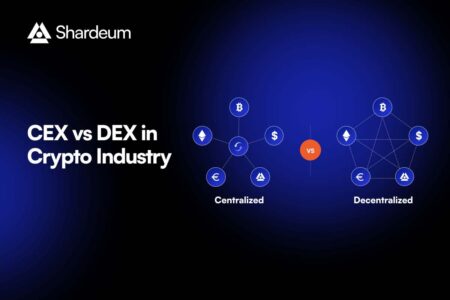The cryptocurrency ecosystem has grown exponentially over the past decade, introducing a variety of trading platforms that cater to diverse investor needs. At the center of this evolution lies a key distinction: Centralized Exchanges (CEXs) vs. Decentralized Exchanges (DEXs). Each has its own advantages, challenges, and ideal use cases, making the choice between them a critical decision for both beginners and seasoned crypto traders.
Understanding the pros and cons of CEXs and DEXs is essential to navigate this fast-paced, high-stakes environment and optimize both safety and profit potential.
What Are Centralized Exchanges (CEXs)?
Centralized exchanges are the most familiar type of crypto trading platform. They operate much like traditional financial institutions, serving as intermediaries that facilitate the buying, selling, and storage of digital assets. Examples include Binance, Coinbase, Kraken, and Bitget itself.
Key features of CEXs:
- Custodial Services: The exchange holds users’ funds and private keys.
- Order Matching: Trades are executed using an internal order book, providing liquidity.
- User-Friendly Interfaces: Designed for easy navigation, often with advanced tools for traders.
- Regulatory Compliance: CEXs adhere to KYC/AML regulations to meet legal standards.
CEXs dominate the market due to their ease of use, liquidity, and customer support, but they also introduce specific risks and limitations.
What Are Decentralized Exchanges (DEXs)?
Decentralized exchanges operate without intermediaries. Users trade directly through smart contracts on blockchain networks, maintaining control over their funds at all times. Popular DEXs include Uniswap, SushiSwap, PancakeSwap, and Curve.
Key features of DEXs:
- Non-Custodial: Users retain ownership of their private keys and funds.
- Automated Market Makers (AMMs): Liquidity is provided through pools rather than order books.
- Permissionless Access: Anyone with a compatible wallet can trade without KYC.
- Transparency: All trades are recorded on-chain, ensuring auditability.
DEXs prioritize decentralization, security, and financial sovereignty, catering to users who value control over convenience.
Pros of Centralized Exchanges
- High Liquidity: CEXs aggregate massive trading volumes, reducing slippage and enabling large trades.
- Speed of Execution: Centralized servers process orders almost instantly, suitable for active traders.
- User Support: Customer service, dispute resolution, and account recovery are often available.
- Advanced Trading Tools: Features like margin trading, futures contracts, and technical analysis tools are widely offered.
- Fiat Integration: Users can deposit and withdraw fiat currency easily, bridging traditional finance with crypto.
These advantages make CEXs ideal for beginners, institutional investors, and high-volume traders who require convenience and reliability.
Cons of Centralized Exchanges
- Custodial Risk: Users must trust the exchange with their funds, exposing them to hacks, mismanagement, or insolvency.
- Regulatory Restrictions: KYC/AML policies may limit access for some users or require personal information disclosure.
- Single Point of Failure: Centralized infrastructure is vulnerable to attacks, outages, and censorship.
- Limited Privacy: All user activity is recorded by the platform, potentially compromising anonymity.
While CEXs are convenient, these risks underscore why some traders are exploring decentralized alternatives.
Pros of Decentralized Exchanges
- Full Control: Users manage their own funds and private keys, reducing custodial risk.
- Permissionless Access: Anyone with a wallet can trade globally without KYC or geographical restrictions.
- Censorship Resistance: No central authority can block trades or freeze accounts.
- Transparency: All transactions are visible on-chain, promoting accountability and trust.
- Innovation: DEXs enable new financial instruments such as yield farming, liquidity mining, and token swaps, often unavailable on CEXs.
These benefits appeal to users seeking autonomy, security, and engagement with the evolving DeFi ecosystem.
Cons of Decentralized Exchanges
- Lower Liquidity: Some DEXs suffer from limited trading volume, which can increase slippage on large trades.
- Complexity: Beginners may find wallet integration, gas fees, and transaction confirmations confusing.
- Slower Execution: Blockchain confirmation times can delay transactions compared to centralized servers.
- Smart Contract Risks: Vulnerabilities or exploits in contract code can lead to significant losses.
- No Customer Support: Users are responsible for their own errors, including lost private keys or incorrect transactions.
DEXs require a higher degree of technical understanding and risk tolerance compared to their centralized counterparts.
Key Considerations When Choosing Between CEX and DEX
- Experience Level: Beginners often benefit from CEXs’ simplicity, while experienced users may prefer DEXs for autonomy.
- Trade Volume: High-volume traders may favor CEXs for liquidity and speed.
- Privacy Concerns: Users prioritizing anonymity may prefer DEXs.
- Asset Variety: Some tokens are only available on DEXs, especially new or niche assets.
- Regulatory Comfort: Users who want to comply with local laws may lean toward regulated CEXs.
Ultimately, the choice depends on individual priorities, including convenience, control, security, and the specific assets being traded.
Hybrid and Emerging Solutions
The line between CEXs and DEXs is increasingly blurred. Hybrid exchanges combine features of both, offering user-friendly interfaces with some non-custodial or decentralized functions. Examples include:
- Binance Smart Chain DEXs: Integration of centralized exchange services with DeFi protocols.
- Layer-2 solutions: Faster, lower-cost decentralized trading options with higher liquidity.
- Cross-chain platforms: Enable token swaps across multiple blockchains, bridging the advantages of both centralized and decentralized systems.
These innovations suggest that future trading may not require choosing exclusively between CEX or DEX, but rather leveraging a spectrum of solutions tailored to user needs.
Conclusion
The debate between centralized and decentralized exchanges is more than technical—it reflects a philosophical shift in finance. Centralized exchanges provide convenience, speed, and support, making them ideal for beginners, institutional traders, and high-volume transactions. Decentralized exchanges, by contrast, emphasize control, transparency, and censorship resistance, appealing to those who value autonomy and innovation.
For the modern crypto investor, understanding the pros and cons of both platforms is essential. While CEXs dominate in liquidity and ease of use, DEXs are leading the charge in decentralization, security, and innovative DeFi features.
Savvy traders may not need to choose exclusively between the two. Instead, combining the strengths of CEXs and DEXs can create a more versatile, secure, and efficient trading strategy. Whether your priority is speed, security, innovation, or autonomy, the evolving exchange landscape offers opportunities for every type of investor—making the choice between centralized and decentralized exchanges not a limitation, but a strategic advantage.










